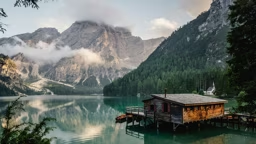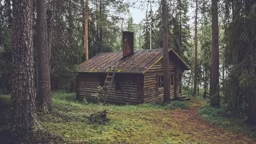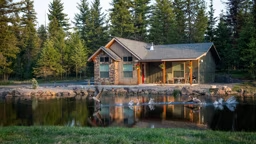At least that’s how it may seem when it comes time to file a claim. You thought your coverage was fairly clear, but it’s only after misfortune befalls your property that you learn all about various exclusions and optional coverage.
So, what’s a cabin owner to do? You’ve heard the phrase, “The best defense is a good offense”? That adage applies here. To avoid confusion, it’s wise to consult your insurance agent before you experience some major cabin crisis. Doing so can save you a lot of headaches, irritation and, best of all – money!
Hopefully you’ll never have to deal with major calamities such as the ones in the following scenarios. But it doesn’t hurt to educate yourself and be prepared. After all, isn’t preparation what insurance is all about?
I thought my insurance covered … damage from a flood.
When the skies opened up during their evening campfire, Jen and Jeff Morgan didn’t think much of it.
They simply grabbed their s’mores and headed inside. But when the rain turned torrential and continued to pound their cabin, a flash flood ensued, and their deck washed away. Their first thought was, “Thank God for homeowner’s insurance!”
But when they spoke to their insurance agent, they learned something they didn’t know before: Water damage is typically covered under homeowner’s insurance only if the cause of loss is due to water that is wind-borne. For example, if hurricane-force winds shattered your cabin’s windows, allowing rain to blow in and soak your hardwood floors, insurance would pay.
Flood damage, on the other hand, is only covered by special insurance purchased through the Federal Emergency Management Agency (FEMA). A flood is defined as any situation where water rises up from the surface. If a lake or stream overflows (even though it may be the result of a rainstorm) and enters your dwelling, that’s flooding. Or if a levee breaks and water pours into your home, that’s flooding. The freak rainstorm that demolished the Morgans’ deck also is categorized as flooding because the heavy rains caused water to rise from the ground’s surface.
Given that their cabin was nowhere near a moderate- or high-risk flood zone, the Morgans never considered purchasing separate flood insurance. But here’s an interesting tidbit. According to Tully Lehman, spokesman for the Insurance Information Network of California, 25 percent of claims paid for flood damage are in areas that are considered low to moderate risk. Hmmm, something to think about.
I thought my insurance covered … the full value of my home and belongings.
Crash! Boom! On occasion, during heavy Midwestern thunderstorms, Liz and Randy Smith enjoyed listening to and watching the thunder and lightning from the safety of their cabin. One April night a real hum-dinger of a spring storm blew over the lake, and around 1 a.m. – Crack!, Sploosh! – a tree fell and caved in part of their roof, destroying not only their beautiful Persian area rug but the 32-inch television that sat in the corner of the room.
The following morning when the Smiths called their insurance agent, they were schooled in the difference between actual cash value and replacement cost. Actual cash value is the actual cash that the insurance company provides to replace a property minus any depreciation
of the item based on its usage.
Replacement cost, on the other hand, pays the dollar amount needed to replace the damaged property without a deduction for depreciation.
“It’s a difficult concept for many folks to comprehend because they see their property value appreciating each year and assume that means their cabin’s structure is appreciating, as well,” says Lehman. “In reality, however, the materials used to build your cabin are actually losing value as it ages due to wear and tear.”
In the Smiths’ case, insurance paid a percentage value based on the roof’s depreciation (i.e., the insurance company paid the actual cost value of the roof rather than the replacement cost). As for the Persian rug and the TV?
Well, the Smiths also got a crash course on two other similar terms: actual cash value for contents versus replacement cost coverage for contents. With actual cash value for contents (which is what a typical policy offers unless you choose to upgrade), insurance provides coverage to purchase the item (in this case, a five-year-old, 32-inch television) minus the depreciation cost of that item (say, 25 percent of the original price of $500), resulting in a settlement of $375. Had the Smiths’ policy been previously upgraded to replacement cost coverage for contents, they could have headed to their local electronics store and purchased a brand new 32-inch television, and insurance would have paid for whatever it cost. This is because with replacement cost coverage the carrier pays the amount it would cost to buy the item in today’s marketplace.
I thought my insurance covered … damage caused by freezing pipes.
It was early March and John Lazwik’s family couldn’t wait to spend spring break at their beloved northeastern cabin. When they stuck their key in the lock and swung open the door, however, their mouths hit the squishy floor. Much of their cabin and its contents were saturated, apparently due to pipes that had frozen, burst, and then thawed.
It wasn’t clear at first if insurance would pay. The claims examiner had to inspect the property to determine the cause of loss. What kind of shape were the pipes in? Had the Lazwiks performed routine maintenance to the pipes, checking periodically for water leakage and rust spots? (Note: If you’re away from your cabin for extended periods of time, you may want to look into technologies such as temperature sensors that can monitor your piping system and detect various problems in your pipes including leaks or low pressure.)
(And another note if you’re away from your cabin for weeks or months at a time: Check your policy for occupancy requirements. Some policies won’t cover this type of damage if no one was in the dwelling within a specific time frame.)
Every carrier is different, but for the most part insurance companies pay for a certain number of circumstances termed “covered causes of loss.” Even so, all “covered causes of loss” are subject to various exclusions including, for instance, “intention of loss” (e.g., purposefully setting a fire to collect insurance money), or “wear and tear” (e.g., neglecting to perform normal upkeep to your pipes).
In the Lazwiks’ case, insurance paid for the damage because the Northeast had experienced record low temperatures that winter. However, when the claims examiner inspected the 25-year-old pipes, he found that some had rust spots, so he suggested the Lazwiks replace the old pipes, which they promptly did. It was a wise choice, not only to help prevent future disaster but also because if the same thing happened again anytime soon, insurance would likely cite negligence and not pay a cent.
“Insurance is made to cover events that you don’t anticipate and can’t keep from happening no matter what you do,” explains Matthew Cullina, property team manager for product development with MetLife Insurance in Warwick, R.I. “Maintenance, however, is in your control.”
Don’t confuse an insurance policy with a household maintenance fund.
I thought my insurance covered … fire damage.
It was a beautiful, cool Southwestern evening, so Cecily Rudolph decided to create a cozy cabin atmosphere by burning some candles. She lit three buttercream votives and set them in the family room’s windowsills, then headed to the kitchen to start dinner. A few moments later a breeze blew a corner of the curtain into the flame. Within minutes, the room was ablaze. Rudolph grabbed the fire extinguisher, and the neighbors came running to help, but it was too late. The family room was gutted.
Rudolph was devastated to lose the central and favorite room of her vintage, 900-square-foot cabin. Soon she received more devastating news. In the 45 years since her cabin had been erected, the county had dramatically changed its building codes. The new laws required that Rudolph demolish her cabin and rebuild it to meet new zoning regulations and government safety standards. This included making the structural walls two inches thicker as well as building the cabin 50 feet farther back from the lake.
Typical property insurance would provide payment sufficient to cover only the damaged part of Rudolph’s cabin (the family room). In contrast, ordinance or law coverage (optional coverage which typically is purchased separately) would provide any type of upgrade that is needed due to building code changes in the local community. Rudolph hadn’t purchased this coverage because she didn’t even know it existed. A lot of people don’t understand why insurance won’t pay for an upgrade that the government requires.
Property insurance contracts promise to restore your home to the way it was. But when state, county or local government steps in and says the way it was is not good enough today – well, that’s not what the insurance company bargained for when it sold you the contract.
Although some high-end policies include ordinance or law coverage, most standard policies do not. In addition, ordinance or law coverage is a bigger issue in some locations than others. For instance, in states with heavy regulations like California (because of the threat of earthquakes), laws require new construction to meet extra measures of safety.
The best way to protect yourself is to ask your agent what type of ordinance or law coverage you have and whether you should buy additional coverage.
Go ahead and give your insurance agent a jingle. He or she can answer all of your questions.
And just for kicks you can share the following cabin riddle: What never goes bad, always looks good, and gets sweeter with age?
Answer: your cabin, of course!
Freelancer Christy Heitger-Casbon’s home once suffered water damage (and insurance paid!) when her washing machine malfunctioned.
A disclaimer: Policies among insurance carriers vary, and each claim is dependent on its own particular facts.
Help!
To help prevent some of the calamities depicted in this article, you may wish to check out these home protection services:
• Arctic Trace, electric heat trace, (907) 522-3004, www.arctictrace.com.
• Heat-Line, electric heat trace, (800) 584-4944, www.heatline.com.
• Protected Home, water and temperature monitor/alert system, (800) 880-6000, www.protectedhome.com.
• Sensaphone, early warning notification, (877) 373-2700, www.sensaphone.com.
• TalkingThermostats.com, (800) 838-8860, www.talkingthermostats.com.











